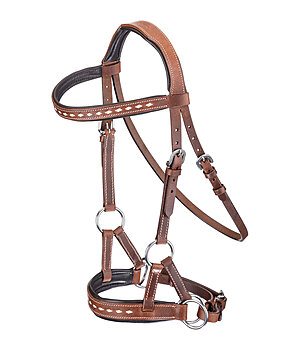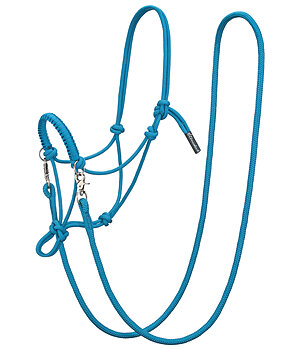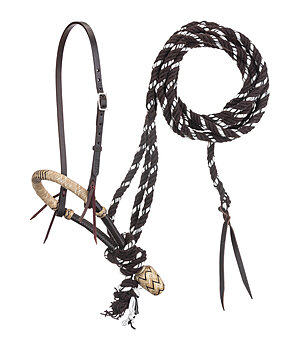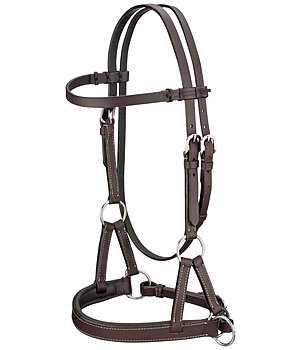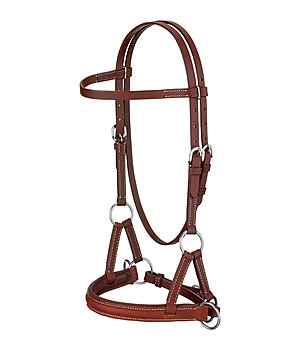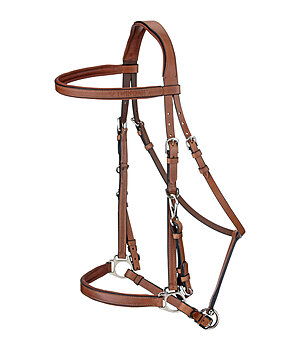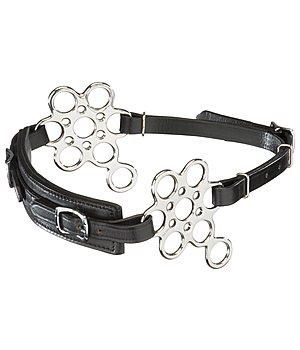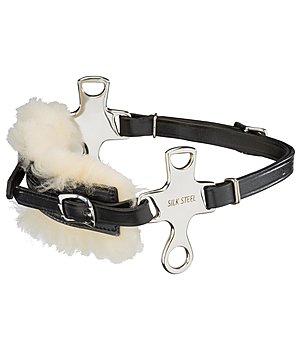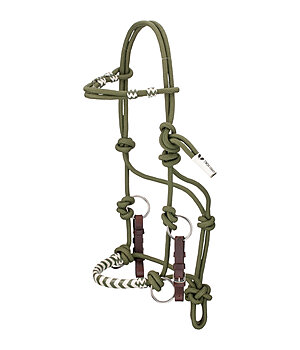A brief digression on bitless Western bridles
Bitless Western bridles are often seen as a gentler alternative to bit bridles. However, this is not always the case. In order to achieve the desired gentler effect of a bitless bridle, it belongs in the hands of experienced riders with a fine hand and with an independent seat, so that the communication between horse and rider theoretically works independently of the rein aids. It therefore requires a great deal of horsemanship – an empathetic relationship between horse and rider – so that the aids are given and understood in the smallest possible doses.

But briefly on the history of bitless riding: already in numerous ancient riding cultures there were bitless variations for various reasons – be it due to the scarcity of materials or the fact that metallic objects were forbidden as a sign of oppression by the Spanish conquistadors, as was the case with the Vaqueros.
The bitless bridles known today, which are used in Western riding, have their origin in the old Californian riding style, which was shaped by the Vaqueros just mentioned. They found alternatives to escape the material restrictions of the conquistadors and used, among other things, the bosal, which was already used in a comparable form on camels in North Africa and the Middle East before the birth of Christ.
Bitless bridles are used today by riders who seek bitless alternatives for a variety of reasons – often because they believe that bitless bridles are „gentler“, or horses with dental health problems or an extremely sensitive mouth an alternative to riding with a bit. Although bitless bridles are gentle on the mouth, they can also have a strong effect, especially on the sensitive nasal bone, if used improperly and with rough rider aids.
But no matter whether you ride with or without a bit. The main focus is always on the prerequisite and the goal of acting as gently as possible on the horse, especially when it comes to rein aids. Bitless bridles, just like bridles with bits, require a fine hand, which only in combination with other aids leads to the horse reacting sensitively to the aids.
In the following we will introduce you to the most popular bitless bridles in Western riding:

Bosal / Californian Hackamore
The bosal – also called Californian Hackamore – consists of the bosal – the braided noseband, which is made of real rawhide, the mecate – this is the rein, which is tied in a special way to the heel knot under the chin of the bosal and the hanger – the leather strap, which serves as a headstall and „suspension“ for the bosal. Combinations with a conventional headstall are also common in some cases.
The mecate consisted exclusively of tail hair in the past and was consequently hard, inflexible and downright „prickly“. In most cases, a gentle touch on the neck with the reins was enough to make the horse avoid contact. This type of aiding via the horse’s neck is also known in Western riding as neck reining. In addition to the influence of the reins on the horse’s neck, it is the influence of the noseband that is decisive with the bosal. The bosal is relatively rigid, so there is still a lot of space between the noseband and the horse’s head. The movement of the reins creates pressure on the bosal, which the horse avoids.

Sensitive noses
Keep in mind that the horse’s nose bone is extremely sensitive and you must use gentle signals to avoid harming your horse. Too hard a rein with a Bosal – as with all bitless bridles – can not only dull the horse’s nose, but can even lead to injuries such as bone damage! In addition, you should only use the bosal when your horse is already a little further trained and can be ridden with impulses. A bosal is not suitable for riding in permanent contact.
What should I look for when buying and using a bosal?
- In contrast to other bitless variations such as a knot rope halter, the following applies to the Bosal: the heavier and thicker the quality, the more intense the impact on the horse. For example, in training young horses, one initially uses more robust designs and increases to thinner and lighter versions as the horse becomes more sensitive. The thickness of the bosal is measured in inches. Standard bosals are usually 5/8 inches thick. Please also take into account the weight of the mecate, which can also exert more pressure on the noseband due to the downward pull.
- The quality of the bosal is essential, especially the noseband which can chafe with inadequate material. The noseband is traditionally and purposefully made of rawhide, while the mecate is now often also made of cotton or nylon and is much softer and more comfortable not only for the horse but also for the rider’s hand.
- The bosal should be adapted to the shape of your horse’s head and should not be too tight, as the amount of leeway is decisive for the influence. The horse should only receive signals at certain points and not be in permanent contact with the bosal. It is usually easy to bend into the right shape. Observe the two-finger rule. Keep two fingers distance from the cheekbone and two fingers distance from the mecate to the horse’s chin.
Why is the hanger always so close to the eye?
Due to the fact that the bosal is not buckled exactly around the horse’s head, but rather simply „hangs down“ by means of the hanger and encloses the horse’s nose with plenty of slack, the leather strap of the hanger often lies quite close to the horse’s eyes. If your horse is sensitive to this, you can use a tie back, which acts as a cheek piece.

How do you tie the mecate?


Sidepull
The sidepull is one of the most well-known and popular bitless bridles. It is used by Western riders as well as dressage, leisure and trail riders. In principle, it is constructed like a conventional noseband and has a movable ring between the noseband and chinstrap to which the reins are attached.
As the name suggests, the sidepull acts laterally on the horse and transfers the traction to the noseband. Originally it was used by Western riders to break in young horses, to support them in learning the lateral driving aids in combination with thigh and weight aids. The effect depends very much on the design of the noseband. A wide noseband made of soft leather distributes the pressure better than a narrow and round stitched noseband.
Variations made of rawhide or rope also have a more localised effect on the nose due to their material composition and therefore require even more sensitivity when giving aids by the rider and a more sensitive acceptance of the aids by the horse.
What should I pay attention to when buying and using the sidepull?
- When buying a sidepull, make sure that it fits your horse perfectly. As the effect is mainly through the noseband, it should not be too deep and should have a 2 finger distance from under the cheekbone.
- When choosing a sidepull, keep in mind the character of your horse and the level of training of both of you. Is your horse very spirited and therefore needs clearer impulses when giving aids? Has your horse been ridden bitless before and is it already familiar with the bitless aids? Does it respond sensitively to your aids? What is the level of training between you and the horse? Do you have a fine hand with the aids?
- In most cases, a wider noseband is recommended for sidepull beginners. If, on the other hand, you have a very spirited horse, a narrower version made of rawhide or ropes is better in order to be able to exert a more targeted influence. This in turn requires a fine and solidly trained rider.
- Ask yourself beforehand in which riding style you would like to ride with the sidepull. It is possible to ride the sidepull in a dressage style, provided it is a sidepull with a wide and soft noseband. With the narrow versions made of rope material, constant contact is counterproductive and can cause the horse pain. In this case, the Western riding style with selective aids on the otherwise long reins is recommended.
- As the influence of the sidepull is oriented to the side, the provision of rein aids to stop the horse is rather limited. Before using the sidepull, make sure that you can rely on your horse to stop well with weight aids, even without rein aids.

Mechanical Hackamore
The mechanical hackamore works similar to a weymouth bit, only on the outside. It is a bridle with a lever action that acts on the nose, chin and poll and thus has a strong effect. The most striking feature of a mechanical hackamore is the shanks, which are held at a distance by a crossbar under the chin. To prevent them from tilting, a mechanical hackamore is ridden with one hand only. Even the smallest impulses reach the horse at the points of action, so that a high level of training is required for the horse and especially for the rider. A hackamore is often used to regulate the speed of very spirited horses.
What should I look for when buying and using a mechanical hackamore?
- Question your level of training and that of your horse. Fine aids are essential to work effectively with the hackamore. If used improperly, the hackamore can cause great damage – especially to the horse’s sensitive nose – and lead to serious injury.
- What kind of riding do you do? Remember that the mechanical hackamore is ridden with one hand only. It is not possible to ride in a contact, as permanent pressure from this riding style has a counterproductive effect.
- The longer the length of the shanks, the stronger the effect of the hackamore. The leverage effect increases with the length of the shanks.

Riding with a knot rope halter – is it possible?
The knot rope halter has its origins in Western riding and is still a popular tool for groundwork and the like. In horsemanship circles, the knot rope halter is also used for training purposes on the horse – for example, as a so-called natural hackamore. Here, a lead rope is attached to the rope halter using a special technique similar to a mecate. In the meantime, there are also special rope halter or trekking halter sets that are equipped with rings for attaching reins.
As with the other bitless bridles, it should be noted that the knot rope halter can cause considerable damage if used improperly and therefore only belongs in experienced hands who can use it to exert a fine influence on the horse.
Due to the nature of the rope and the small thickness a pull on the knot rope halter has a direct and localised effect, whereas the pressure is better distributed with a conventional headcollar with wider straps.
Therefore, the following also applies when riding with a knot rope halter: The training level of horse and rider must be at a high level. The horse should react to the rider’s fine aids so that a gentle and sensitive communication can take place.
Bitless bridles at Kramer Equestrian
Always observe competition rules and regulations
Especially in Western riding, there are different sets of rules that have to be observed, depending on which association is the competition organiser.
Before participating in a show, be sure to check the applicable show rules and, if necessary, ask the organiser which equipment is permitted!



